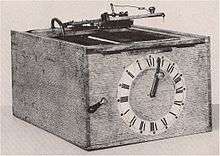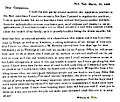Typographer (typewriter)

The typographer, America's first typewriter, was invented and made by William Austin Burt. It was a mechanical device that was worked by hand to make the letter print on paper. The working model provided by Burt for his 1829 patent was destroyed in the 1836 Patent Office fire. The main purpose of the device was to speed up secretarial work, although that ultimately was not accomplished.[1][2]
History
The typographer was patented on July 23, 1829, as U.S. patent No. 5581X.[3] United States Patent Office documents describe Burt's American machine as "the actual construction of a type writing machine for the first time in any country".[4] It was the first practical typewriting machine ever made in America,[5] although Pellegrino Turri had made one in Italy in 1808.[6] The patent gave Burt the full exclusive rights to his new typewriter machine for 14 years, including vending or selling to others any or all of these rights as he saw fit, signed by President Andrew Jackson.[1]
All "type writing" machines, those that used letters of typeface, were generally given the name "typographer" from Burt's 1829 patent until 1874 by subsequent inventors who improved on Burt's machine.[7] The concept ultimately came to be called "The Type-Writer" in 1874.[5][8] The word stayed hyphenated until the 1880s. William Ozmun Wyckoff, president of the New York State Shorthand Reporters' Association in 1886, and founder of the Remington Typewriter Company, publicized the unhyphenated name "typewriter". It became very well known, and the public finally accepted this as one word by 1919.[9] Eventually, Burt's typographer was called a typewriter.[10]
French authors, Henri Dupont and C. Senechal in their book "Les machines a écrire: historique, avantages, descriptions et traité complet de dactylographie ou art d'écrire a la machine" in 1906 described the facts about Burt's typographer machine as has been described above.[11]
In 1714, the British patent office issued a patent to English engineer Henry Mill for a typewriter; however, he never built it.[12] This first record of an initial attempt gave Mills time (14 years) to develop a model or at least a description of his "artificial machine"; however, the secret of how to make such a machine, if there ever was one, died with him.[13] There is no record that it ever existed.[14] There hasn't even been found a trace of any drawings or specifications.[15] Its description is more like that of making embossing tape, which product output would be used for the blind.[15]
Christopher Latham Sholes is given credit for inventing the first "practical" typewriter.[2] He was in fact the fifty-second person or possibly the 112th to reinvent a "type-writing" machine – which he called a type-writer.[16][17] Some of the "type-writing" machines invented between Burt's 1829 patented machine and Sholes' 1867 type-writer are "The Projean Machine" (1833), "The Thurber Machine" (1843), "The Foucault Machine" (1843), "O. T. Eddy's machine" (1850), "The Fairbanks machine" (1850), "J. M. Jones' machine" (1850), "William Hughes' machine" (1851), John M. Jones "mechanical Typographer" (1852), "Thomas' typograph" (1854), "The Beach typewriter" (1856), "The Francis Typewriter" (1857), "The Hansen Machine" (1865), "The Livermore Printing Device" (1863), "Peeler Writing Machine" (1866), and "The Sholes and Glidden Typewriter" (1867) invented by three men (C. Latham Sholes, Samuel W. Soule, Carlos Glidden).[2][18] Thomas Edison is even given credit for an electrified version in 1872.[2]
The Board of Electors at the National Shorthand Association of Detroit recognized Burt as:
- leader among typewriter inventors
- top American inventor in the world-wide field of typewriting machines.[11]
Patent



The machine was a rectangular wooden box 12 in (300 mm) wide, 12 in (300 mm) high, and 18 in (460 mm) long. It mechanically worked by depressing a rotating lever so that an inked letter made contact with paper. A gauge that was designed in a circular clockwise fashion on the front of the box indicated the number of lines typed on the blank piece of paper that was up to 15 inches in length. The paper was attached to a velvet-like material belt. The belt rotated when the impression lever was depressed.[19]
The patent describes Burt's machine as having a set of typeface characters that were arranged on the under side of a set of parts that had a lever pivoted to swing vertically and horizontally. The desired typeface character is brought to the printing point by moving this lever horizontally to a position over the same character in the index, and the impression on the paper is made by then depressing the lever. Different styles of typeface characters could be used. They were arranged in two rows on a lever. The rows of typeface characters could be shifted on the lever to bring either one to the printing point. The paper was carried in an endless band that traveled crosswise of the machine and the band was moved for letter space by the impression lever every time the lever is depressed to print. The line space was made by shifting the frame carrying the printing mechanism toward the front or rear of the machine, with the paper remaining stationary. Ink-pads were located at each side of the impression point, and all the typeface characters, except the one in the printing position, were inked every time the impression lever was depressed. Upper and lower case typeface letters could be used. A dial was provided that indicated the length of paper (inches) which had passed the printing point in printing each line. The operator knew the width of the paper being used each time. There was a stop printing indicator for end of the line.[3][5]
Four classes of typewriters had been recognized by the U. S. Patent Office. The first was an index-wheel machine, like that patented by Burt on July 23, 1829. The second was the bar-machine first patented by John B. Fairbanks on September 17, 1850. The third was the plate-machine first patented by Oliver T. Eddy on November 12, 1850. The fourth was the key-wheel machine first patented by John Pratt on August 11, 1868.[9]
A complete working model of Burt's "typographer" was in the model room of the Patent Office from the time of the patent until the great Patent Office fire of December 15, 1836.[5][7] The fire destroyed all the patents and patent models issued from 1790.[20] A competent mechanic can build a working replica of Burt's typographer from his patent description and drawings.[9] In fact Austin Burt, the great grandson of Burt, built a working model in 1892 for the World's Columbian Exposition working from a parchment copy of the original patent (No. 5581X).[5][21]
The reason Burt built the machine was to speed up his work in official correspondence as a government surveyor. John P. Sheldon of the Detroit Gazette, Burt's newspaper editor friend, furnished the typeface letters from the newspaper company for Burt's first typographer to be able to type the first letter ever written on a typewriter. Sheldon also took Burt's first "moddle" to the Patent Office in Washington, D.C. sometime between March 9 and 12, 1830, as Burt writes about on March 13, 1830, on his second typographer typewriter he built. The typeface letters for this Patent Office model was obtained from a Mr. White of New York, a typeface founder. Even though a neat-looking letter could be typed on Burt's "typographer", the basic goal to speed up correspondence was not accomplished, as his machine was very slow in typing. Because of this, the machine could not get marketed. Burt lost interest in it and sold his rights to one Cyrus Spalding for $75 on March 17, 1830 with suggested improvements. Ultimately he did not have any further luck in marketing the typewriter.[21][22] The typographer was so far ahead of its time it found no market.[5]
 Typed typographer letter by Burt in 1830 to his wife[23]
Typed typographer letter by Burt in 1830 to his wife[23] Letters Patent 1829 – signed by President Andrew Jackson
Letters Patent 1829 – signed by President Andrew Jackson
References
- 1 2 Burt, p. 14
- 1 2 3 4 Linnoff, pp. 10–14
- 1 2 Patent 5581X
- ↑ Fuller, 191
- 1 2 3 4 5 6 White, pp. 367–68
- ↑ Revett, Kenneth (September 15, 2008). Behavioral Biometrics: A Remote Access Approach. John Wiley & Sons. p. 222. Retrieved June 28, 2014.
- 1 2 Kidder, p. 12
- ↑ Baron, p. 201
- 1 2 3 Fuller, pp. 188–189
- ↑ Michigan history, Volume 8, p. 413, George Newman Fuller, Lewis Beeson, Michigan Historical Commission, Michigan State Historical Society, Michigan Department of State, 1924
- 1 2 Fuller, p. 193
- ↑ Kane, item 3585
- ↑ The Rotarian, Oct 1923, p. 18, article: "The Machine Gun of Commerce", by Arthur Melville
- ↑ Appleton, p. 7
- 1 2 Burt, p. 22
- ↑ Baron, p. 200
- ↑ Adler, p. 159
- ↑ Appleton, pp. 7–8
- ↑ Burt, p. 13
- ↑ "The Raiders of the Lost Archives, in 1836, fire destroyed 10,000 patents, and the U.S. has hunted them ever since". Lexington Herald Leader. August 16, 2004. Retrieved April 23, 2016. (Subscription required (help)).
- 1 2 Burt, p. 21
- ↑ Michigan History Magazine, article: "Willian Austin Burt", January 1922
- ↑ Fuller, 192
Sources
- Adler, Michael H., The Writing Machine, A History of the Typewriter George Allen & Unwin Ltd, 1973, ISBN 0-04-652004-X
- Appleton, D., The Universal Cyclopaedia, Volume 12 of The Universal Cyclopaedia: A New Ed. Prepared by a Large Corps of Editors, Assisted by Eminent European and American Specialists, Under the Direction of Charles Kendall Adams ... Editor-in-chief; Illustrated with Maps, Plans, Colored Plates, and Engravings, Publisher: D. Appleton, 1900
- Burt, John A., They left their mark: William Austin Burt and his sons, surveyors of the public domain, Landmark Enterprises, 1986, ISBN 0-910845-31-X
- Fuller, George Newman, Michigan history, Volume 6, Michigan Department of State, 1922
- Kane, Joseph Nathan, Famous first facts : a record of first happenings, discoveries, and inventions in American history, H.W. Wilson, 2006, ISBN 0-8242-1065-4
- Kidder, Harry M., Transactions of the New York State Shorthand Reporters' Association at the fourth–fifth annual meeting held at December 28, 1920, BOYD PRINTING CO., INC., ALBANY, N. Y., 1921
- Linnoff, Victor M., The Typewriter, an illustrated history, Dover Publications, 2000, ISBN 0-486-41237-7
- Rotary International, The Rotarian, Oct 1923, 56 pages, Vol. 23, No. 4, ISSN 0035-838X
- White, James T.Cyclopedia of American Biography, volume xviii, 1922